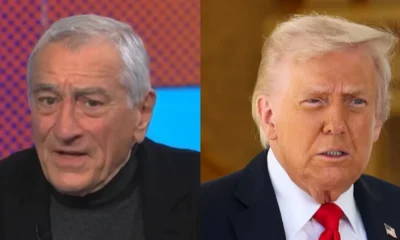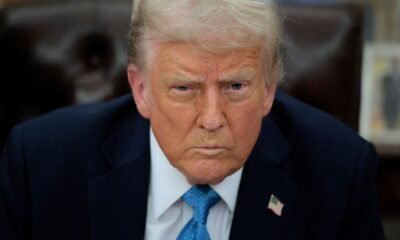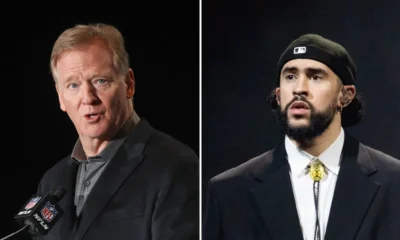Politics
Who Is Graham Platner — The Maine Senate Candidate Making Waves for All the Wrong Reasons

When Graham Platner, a 41-year-old veteran and oyster farmer from Maine, launched his U.S. Senate campaign in August 2025, few could have predicted how quickly his name would explode into national headlines.
Framing himself as a fighter “against the oligarchy of billionaires and corrupt politicians,” the former U.S. Marine Corps combat veteran struck a populist tone — and it worked. Within six weeks, his campaign reportedly raised $3.25 million, an impressive feat for a first-time candidate.
He also caught the attention and endorsement of Bernie Sanders, the influential independent senator from Vermont, who praised Platner’s working-class background and commitment to reform. Sanders’ endorsement on X boosted Platner’s image as a grassroots contender ready to take on Washington’s elite.
ALSO READ : Rockets Guard Fred VanVleet Tears ACL and Likely to Miss 2025-26 Season
But as the election nears, that once-inspiring story has been overshadowed by controversy — involving Reddit posts from 2018 and a tattoo some associate with Nazi imagery.
A SOLDIER TURNED FARMER TURNED POLITICIAN
Platner was born and raised near Acadia National Park in northern Maine. After graduating high school, he enlisted in the U.S. Marine Corps, serving four tours in Iraq and Afghanistan. Those experiences, he says, shaped his belief in public service and his distrust of entrenched political power.
After leaving the military, Platner settled along the Maine coast, where he started a small oyster farm, employing local veterans and fishermen. His story — a war veteran who returned home to cultivate the ocean and now seeks to reform Washington — initially made him a media darling.
“Washington doesn’t need more politicians,” Platner said in a recent campaign video. “It needs fighters.”
THE CONTROVERSY: A TATTOO AND OLD POSTS RESURFACE
That image of a disciplined Marine and humble worker began to crack in October when journalists uncovered a tattoo of a skull and crossbones on Platner’s upper arm.
According to The Guardian and Politico, the design closely resembled the Totenkopf — a symbol used by Nazi SS units during World War II.
Platner quickly addressed the issue in a press conference, saying the tattoo was “a dumb mistake made by a 20-something Marine on shore leave.” He later revealed he had the tattoo covered up, adding, “I am not a secret Nazi.”

“My life has been dedicated to antifascism, antiracism, and fighting hate in all its forms,” Platner told The Washington Post.
Compounding the problem, screenshots of old Reddit posts from 2018 resurfaced, allegedly written by Platner under a pseudonym. The posts included disparaging comments about police, rural Americans, and women.
Platner confirmed that he made the posts, saying they were written during a “dark and angry” period after his military service. “I was a different person then,” he said. “Combat trauma doesn’t excuse bad behavior — but it explains why I was lost.”
POLITICAL DAMAGE CONTROL
Despite the controversies, Platner’s campaign insists the backlash is a coordinated effort to derail his populist surge. His campaign manager, Erin McAllister, argued that “powerful interests” fear Platner’s independence and outsider message.
Supporters say the uproar reflects a double standard. “He’s being attacked for something he already corrected,” said a veteran supporter on Reddit. “Meanwhile, Washington politicians get away with far worse.”
Even Bernie Sanders has so far stood by his endorsement, though he has not commented publicly since the controversy broke.
A RACE THAT COULD CHANGE MAINE POLITICS
Platner is challenging incumbent Susan Collins, the veteran Republican senator whose moderate stance has kept her in office for over two decades.
Polls show Platner trailing by single digits — remarkable considering his lack of political experience.
Analysts from Reuters and FiveThirtyEight note that if Platner maintains his funding pace, he could force the race into a genuine toss-up by late October.
But with his name now tied to headlines about Nazi symbolism and online outrage, even allies admit the campaign faces an uphill climb.
“He started as a story about working-class grit,” said political strategist David Axelrod. “Now, it’s a story about damage control.”
WHO IS GRAHAM PLATNER, REALLY?
Platner’s supporters paint him as a straight-talking reformer — a Marine who served, suffered, and came back determined to fix a broken system. Critics, however, question his judgment, his past behavior, and his readiness to represent an increasingly polarized America.
One thing is certain: Graham Platner’s campaign has transcended Maine politics and entered the national conversation — as a case study in how quickly digital pasts can collide with present ambitions.
Politics
Big Cities, Bigger Stakes: Which Mayors Are Up for Grabs on November 4?
From New York City to Boston and Seattle — the 2025 mayoral elections could reshape leadership across America’s most powerful urban centers.

The Battle for America’s City Halls Begins
The 2025 municipal election season is heating up — and while it’s not a presidential or midterm year, the political consequences could ripple far beyond city limits. On Tuesday, November 4, millions of voters will cast their ballots in mayoral races that define the future of some of the country’s most influential cities — from New York City to Atlanta.
These elections span seven major metropolitan areas — New York City, Boston, Seattle, Cleveland, Detroit, Minneapolis, and Atlanta — together home to more than 11.8 million people.
Let’s take a closer look at the cities — and the leaders — shaping this pivotal local election season.
ALSO READ : Rockets Guard Fred VanVleet Tears ACL and Likely to Miss 2025-26 Season
The New York City mayoral race has grabbed national headlines, largely thanks to the clash between progressive newcomer Zohran Mamdani and establishment heavyweight Andrew Cuomo.
Which U.S. Cities Are Electing New Mayors in 2025? Inside the Races in NYC, Boston, and Seattle
Mamdani, a Democratic Socialist and current New York State Assembly member, is leading most polls with roughly 45 percent support. His campaign has captured the imagination of younger and working-class voters, framing itself as a fight for affordable housing, transit reform, and economic equity.
Cuomo, the former Governor of New York, is running as an independent in what analysts call a “political redemption tour.” Despite scandals that led to his 2021 resignation, Cuomo has found traction among moderate Democrats and older New Yorkers nostalgic for his leadership.
Meanwhile, Republican candidate Curtis Sliwa — founder of the Guardian Angels — continues to appeal to law-and-order conservatives, polling around 15 percent.
“We’re witnessing a generational and ideological realignment of urban politics,” said Mark Levine, Manhattan Borough President, in an interview with local media.
Early voting began October 25, and turnout has already surpassed expectations.
Boston: Michelle Wu’s Near-Certain Second Term
In Boston, Mayor Michelle Wu is cruising toward reelection, facing little serious opposition.
Her closest challenger, Josh Kraft, a nonprofit executive and son of Robert Kraft — owner of the New England Patriots — withdrew after the preliminary round, virtually guaranteeing Wu’s victory.
Wu’s administration has been praised for tackling housing affordability and public transit issues while maintaining strong ties with Boston’s tech and education sectors. Her unopposed run speaks volumes about her approval ratings — but also raises questions about local competition in the city’s political ecosystem.
Seattle: A Progressive Tide in the Pacific Northwest
In Seattle, the race between incumbent Mayor Bruce Harrell and challenger Katie Wilson is tightening by the day.

Harrell, a centrist Democrat, has highlighted his record on public safety and homelessness, while Wilson — a community organizer — has energized grassroots supporters by promising bold housing reforms and climate-forward city planning.
The primary election in August shocked many when Wilson narrowly outpolled Harrell, setting up what observers call a “progressive vs. pragmatist” showdown.
“This race reflects a generational divide in how cities approach progressivism,” noted Norm Rice, Seattle’s first Black mayor.
Cleveland and Atlanta: Local Leadership in Transition
In Cleveland, Mayor Justin Bibb — one of the youngest big-city mayors in the U.S. — faces a re-election challenge from businesswoman LaVerne Gore.
Meanwhile, Atlanta Mayor Andre Dickens seeks a second term amid debates over crime reduction, affordable housing, and Atlanta’s controversial “Cop City” training facility project.
Both races are seen as referendums on urban reform: can progressive mayors maintain momentum when voters demand stronger safety and economic results?
Minneapolis and Detroit: Battling for Community Trust
In Minneapolis, the race between incumbent Jacob Frey and activist Sheila Nezhad is once again dominated by public-safety reform, five years after the George Floyd protests transformed city politics.
Detroit, under Mayor Mike Duggan, faces an economic-revival test — with challengers promising to deliver more equitable redevelopment in post-industrial neighborhoods.
Why These Mayoral Races Matter Nationwide
Although these are local contests, the outcomes may shape national Democratic Party strategy ahead of 2026 midterms. Urban mayors often serve as testing grounds for new policies — from housing and public transit to policing and climate resilience.
Political analyst Van Jones wrote on X that “City Halls are where the next generation of national leaders are born — or broken.”
With cities now at the forefront of America’s cultural and economic debates, the November 4 elections promise not just new mayors — but new directions for how U.S. cities define leadership itself.
Politics
Trump’s $300 Million White House Ballroom Sparks Uproar as Entire Fine Arts Commission Is Fired
In a stunning shake-up, all six members of the U.S. Commission on Fine Arts were dismissed amid backlash over President Donald Trump’s plan to build a massive 90,000-square-foot ballroom at the White House.

The White House has become the epicenter of another storm — and this time, it’s not about politics, but architecture. In a move that stunned Washington insiders and preservationists alike, President Donald Trump’s administration has fired all six members of the U.S. Commission on Fine Arts, the federal body that traditionally oversees design integrity in America’s most iconic buildings.
The firings come just a week after demolition began on the White House’s East Wing to make space for a $300 million, 90,000-square-foot ballroom — a project Trump reportedly sees as a “monument to American greatness.”
A White House official told USA Today that the administration plans to appoint a new slate of commissioners who are “more aligned with President Trump’s America First vision.”
ALSO READ : Rockets Guard Fred VanVleet Tears ACL and Likely to Miss 2025-26 Season
A Historic Commission Dismissed
The U.S. Commission on Fine Arts, established by Congress in 1910, has long served as the guardian of Washington’s visual and cultural identity. It advises the President, Congress, and the National Park Service on matters of design, aesthetics, and preservation. The wholesale dismissal of its members is rare — the last comparable instance occurred over half a century ago.
Among those ousted are prominent architects and art historians who had been vocal about the need to protect the White House’s architectural heritage. Their removal has sparked outrage among preservation groups, including the National Trust for Historic Preservation, which has urged an immediate halt to demolition.
Preservationists Sound the Alarm
In a strongly worded letter, Carol Quillen, president and CEO of the National Trust for Historic Preservation, warned that the proposed ballroom could “overwhelm the White House itself.” She pointed out that the mansion currently comprises just 55,000 square feet — meaning the new addition would nearly double its size.
Quillen’s organization has asked the National Capital Planning Commission (NCPC) and the National Park Service (NPS) to enforce federal review processes before further work continues. “We are deeply concerned that this project bypasses the legally required consultation procedures,” the letter stated.

Critics Call It “Architectural Hubris”
Former First Lady Hillary Clinton joined the chorus of critics, calling the demolition of the East Wing “a reckless erasure of history for vanity’s sake.” Clinton, who once oversaw restorations of the White House interiors during her tenure, said the ballroom “represents more ego than elegance.”
Architectural experts have echoed these concerns, calling the scale of the project “unprecedented.” One former commission member, speaking anonymously to The Washington Post, described the plan as “architectural hubris — a personal statement disguised as public space.”
Trump’s Vision: “A Ballroom for the People”
Despite the backlash, Trump’s aides insist that the project reflects his vision to create “a space worthy of state functions, global diplomacy, and cultural excellence.” According to insiders, the ballroom — adorned with gilded chandeliers and marble floors — is designed to host everything from state dinners to cultural galas.
Supporters of the project argue it will “cement Trump’s legacy as the President who brought grandeur back to the White House.” They compare it to the Versailles-style expansions of European palaces, suggesting that the ballroom could become “America’s new architectural marvel.”
However, critics counter that such comparisons betray the White House’s very spirit — a building intended to represent democracy, not monarchy.
Legal and Political Fallout Looms
Legal experts warn that bypassing the National Environmental Policy Act (NEPA) review and the NCPC process could expose the administration to lawsuits. “Demolishing a federally protected structure without proper review violates multiple preservation laws,” said one former NPS official.
Congressional Democrats are reportedly exploring options to freeze funding for the project until a full review is conducted. Nancy Pelosi has called for an “immediate congressional inquiry” into the demolition, while Republican allies have framed the controversy as “part of Trump’s ongoing war against bureaucracy.”
The Bigger Picture: Art, Power, and Legacy
This latest controversy underscores Trump’s ongoing battle with cultural institutions. From proposing “patriotic education” to altering the design of federal buildings, the former president has long sought to reshape America’s aesthetic identity.
Political historian Jon Meacham told CNN that the ballroom project “perfectly captures the Trump era — a blend of ambition, disruption, and disregard for convention.”
If completed, the 90,000-square-foot ballroom would become the single largest expansion of the White House in over a century, dwarfing additions made during the Harry S. Truman renovation of the 1940s.
What’s Next for the White House?
As demolition continues, uncertainty looms. Will the courts intervene to halt construction, or will the Trump administration press ahead in defiance of critics?
For now, the White House remains a construction zone — both literally and symbolically. The battle over its walls has become a battle over America’s soul, where preservation meets populism, and history collides with ambition.
Politics
Gavin Newsom Breaks Silence on Presidential Ambitions — ‘I’d Be Lying If I Said I’m Not Considering It
California Governor Gavin Newsom finally admitted he is giving “serious thought” to running for the White House, ending months of speculation about his political future and reigniting talk of a 2028 showdown that could reshape the Democratic Party.

After years of speculation and political whispers echoing through Sacramento and Washington, California Governor Gavin Newsom has finally said out loud what many already suspected — he’s considering a run for president.
In a candid interview aired on CBS News Sunday Morning on October 26, Newsom didn’t shy away from the big question. When asked whether he was seriously thinking about a White House bid, his response was refreshingly direct:
“I’d be lying otherwise. I’d just be lying. And I’m not — I can’t do that.”
With that one line, Newsom pulled back the curtain on months of intrigue and firmly planted himself back into the national political conversation.
A Carefully Timed Admission
Newsom’s comment comes as the Democratic Party begins to regroup ahead of the next presidential cycle. The 56-year-old governor said he plans to make a decision after next year’s midterm elections, a timeline that would allow him to gauge both national sentiment and the direction of his party.
ALSO READ : Fans Can’t Believe Susan Boyle’s Stunning New Look… “She’s Unrecognizable!”
For years, Newsom has been regarded as a rising star among Democrats, known for his progressive policies and polished charisma. He’s been on the shortlist of potential presidential contenders ever since Joe Biden ended his 2024 campaign and endorsed Kamala Harris for president.
Even then, Newsom remained one of the Biden-Harris campaign’s loudest defenders, stumping tirelessly across states and using his growing national profile to rally support for the Democratic ticket.
Political analyst David Axelrod once described Newsom as “a governor with the ambition of a president and the energy of a campaigner who never stops moving.”
The Democratic “Resistance Leader”
Since Donald Trump began his second term in January, Newsom has reemerged as one of the loudest voices in the Democratic resistance, taking aim at Republican policies and personalities — especially Trump and Vice President JD Vance.
On social media, Newsom has become a combative presence, unafraid to spar publicly with conservative leaders over issues ranging from climate policy to abortion rights. Clips of his fiery debates have gone viral, with supporters dubbing him the “California counterpuncher.”
In one of his most shared posts, Newsom fired back at Vice President Vance over immigration policy, writing on X:
“California won’t be lectured about compassion or law by a government that cages children and bans books.”
The post garnered millions of views and solidified Newsom’s image as a sharp-tongued liberal who knows how to wield social media like a weapon.

Legal Battles and Legislative Ambitions
Beyond his online persona, Newsom has positioned California as the defiant blueprint of liberal governance. His administration has launched multiple legal challenges against federal directives, including the controversial deployment of thousands of National Guard troops to Los Angeles earlier this year — a move he condemned as “politically motivated.”
He is also championing Proposition 50, a ballot measure designed to redraw California’s congressional districts through 2030. The initiative would add five Democratic-leaning seats, countering Texas’s redistricting push and solidifying California’s role as a liberal stronghold in national politics.
Political strategist James Carville told Daily Global Diary, “Newsom’s smart. He’s not declaring early. He’s testing national waters while keeping California as his stage. Every policy fight becomes a campaign preview.”
A Balancing Act Between Loyalty and Ambition
Despite his growing prominence, Newsom has walked a fine line between party loyalty and personal ambition. He was one of the earliest Democratic figures to publicly back President Biden’s re-election campaign, even when speculation swirled that he might challenge him. After Kamala Harris secured the 2024 nomination, Newsom became one of her most effective surrogates, often filling arenas with passionate supporters.
Still, his recent comments mark a shift — from supportive surrogate to potential successor. His acknowledgment of presidential ambitions could transform the Democratic landscape, setting up what many believe could become a Newsom vs. Harris rivalry in 2028 if she seeks a second term.
“Governor of California or Future Commander-in-Chief?”
In the CBS interview, Newsom was careful not to appear overeager, but his phrasing left little doubt about his aspirations. Asked whether he saw himself as presidential material, he smiled and said, “I see myself as someone who’s not afraid to lead. Wherever that takes me, we’ll see.”
Those close to him say his decision may depend on two key factors: the outcome of next year’s midterm elections and the trajectory of Democratic voter sentiment after years of deep partisan divides.
His record in California gives him a strong base — from record infrastructure investments and climate legislation to his controversial pandemic policies that drew both praise and criticism.
A Political Future That Feels Inevitable
If Gavin Newsom does throw his hat into the ring, he’ll bring with him not only the power of the nation’s largest state economy but also a national following that has grown steadily since his days as mayor of San Francisco.
With charisma, name recognition, and political combativeness in equal measure, Newsom could very well be the next big contender to define what the Democratic Party looks like post-Biden.
As political commentator Van Jones put it:
“Gavin Newsom isn’t just running California. He’s running a long-term audition for the presidency — and now, he’s finally admitted it.”
-

 Entertainment6 days ago
Entertainment6 days agoRobert De Niro slams ‘King Donald I’ and calls Americans to rise again — says ‘we can’t let up’ against Trump’s bullying tactics
-

 Entertainment3 days ago
Entertainment3 days agoFans Can’t Believe Susan Boyle’s Stunning New Look… “She’s Unrecognizable!”
-

 Politics5 days ago
Politics5 days agoWhy Donald Trump Suddenly Ended All Trade Talks With Canada — And the Unexpected Role of Ronald Reagan
-

 Sports1 week ago
Sports1 week ago“Chasing more than a conference crown… Purdue Boilermakers set sights on national glory after historic preseason No. 1 nod”
-

 Politics5 days ago
Politics5 days agoCharlotte Train Horror: Why a Ukrainian Refugee’s Killing Has Sparked a Death Penalty Case That’s Shaking America
-

 Sports1 week ago
Sports1 week agoHistory made! Purdue Boilermakers grab first-ever No. 1 spot in USA TODAY Sports preseason men’s basketball poll — can they finally win it all?
-

 Entertainment6 days ago
Entertainment6 days agoDonald Trump fumes as Bad Bunny becomes first-ever Spanish-only Super Bowl headliner — NFL says decision was ‘carefully thought through’
-

 Politics1 week ago
Politics1 week agoPoll shocker: Donald Trump’s approval rating climbs as Americans surprisingly back a Palestinian state




















